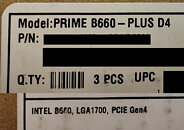Thursday, November 11th 2021

Intel B660 Motherboards May Lack PCIe 5.0 Support
The ASUS PRIME B660-PLUS D4 has allegedly been inadvertently sent instead of an ASUS Z690 motherboard to a reviewer for Alder Lake testing. The reviewer provided images of the product packaging to VideoCardz which clearly show a label indicating PCIe 4.0 support. This has come as a surprise as the Intel 12th Generation Alder Lake processors include attached PCIe 5.0 lanes separate from the chipset. The B660 chipset will target the mid-range market so the lack of PCIe 5.0 support on this specific motherboard may be a cost-cutting or artificial separation measure.
The first consumer PCIe 5.0 graphics cards and SSDs aren't expected to arrive until H1 2022 and will likely come at a significant premium so the exclusion of support could make sense for a more budget-oriented platform. Intel is also preparing to launch a higher-end H670 chipset which is expected to include PCIe 5.0 support. We cannot be sure if this label is accurate and if the lack of PCIe 5.0 support will apply to all B660 motherboards so take these rumors with a healthy dose of skepticism until the chipset and motherboards are officially unveiled.
Source:
VideoCardz
The first consumer PCIe 5.0 graphics cards and SSDs aren't expected to arrive until H1 2022 and will likely come at a significant premium so the exclusion of support could make sense for a more budget-oriented platform. Intel is also preparing to launch a higher-end H670 chipset which is expected to include PCIe 5.0 support. We cannot be sure if this label is accurate and if the lack of PCIe 5.0 support will apply to all B660 motherboards so take these rumors with a healthy dose of skepticism until the chipset and motherboards are officially unveiled.

78 Comments on Intel B660 Motherboards May Lack PCIe 5.0 Support
I think there is some overhead improvements that were made in gen 3 as well in terms of achievable data rates, so I would expect 3x4 to be a bit better than 1x16.
Just read it now, the link didnt show very easily in your reply, but found it when hovering, the load that TPU put on the card suggests the 3080s need more bandwidth than I thought, but still would probably be comfortable on 4x4 and 3x8, so with directstorage maybe 4x8, depending on the bandwidth requirements of directstorage, I have assumed no compression of data so a worse case scenario..
Since the Hx10 series always be the entry level lineup
BTW since I'm talking outta my aß here, will Zen 3+ bring new chipset or new chipset coming with Zen 4?
Whether "business oriented" is what Intel says or what the real world actually uses is a discussion I'd rather not have ;)
H170 and older (H97, H87) boards used to be quite common. Q too. It looks like things have changed a lot since then, and H570 and Q570 are a rare sight now.
Checkbox feature, just like PCIe 4.0 before it.
they still lock CPUs multiplier and charge a premium to unlock it
they wasting a golden opportunity to put the E-Core in all of the SKUs from top to bottom since 4 E-Cores take the die space of one P-Core, the locked i5 & i3 & pentium could really benefit from such hybrid design
and they should've focused on making the DMI PCI-E gen 5
and the whole Z & B chipset thing should be a thing of the past in my opinion, just make one bloodddy chipset
the i5-12600k is a beast of a CPU that is ruined by the platform cost, motherboard are ripping you blind, Z690 are the most expensive boards i've seen in a mainstream lineup
and the cheaper ones are DDR4 only, why would anyone buy an alder lake just to pair it with a DDR4
You have just complained about the high cost of the platform and now you're saying everyone should use RAM that's twice as expensive? :wtf:
I think its great B chipset ditches things that are no longer important, for me, CPU overclocking days are over, they perform so well out of the box, amd also not been forced to pay the PCIe5 gen tax as well.
I think five (six?) chipsets per generation is excessive though. A high-mid-low range makes sense, and I guess one for business with vPro and one for Xeon workstations also makes some sense - though ideally those would just be kept separate in some way. They could at least give them useful and understandable designations. If B is supposed to stand for business, it's weird that they don't support vPro and are universally seen as the "not Z" consumer option. If H stands for Home, why have they never been used in consumer-oriented motherboards to any extent? Why are Hx70 and Qx70 the same number, yet have very different featuresets? Why is Bx60 severely cut down compared to the x70 ranges, despite just being 10 lower in number?
Possible solutions: Make the business chipsets vPro versions of the other chipsets. I.e. instead of Z490, W480, Q470, H470, B460 and H410, you'd have Z490, Z490 vPro, B460, B460 vPro, and H410. Let the BIOS decide whether to unlock OC functionality and the like based on what CPU is installed, instead of using bespoke chipsets for every single little thing. The vPro versions wouldn't be sold much at retail anyway, and OEMs would have the option to flash vPro BIOSes to their PCs at will, without needing to manage stock for 5-6 different pieces of silicon.
If anything, this just mirrors Intel's CPU naming woes: the segmentation itself makes sense in some way, but the naming is confusing and messy to such a degree that it completely undermines the segmentation and makes it seem arbitrary and weird.